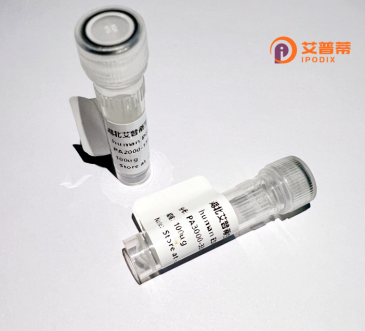
| 纯度 | >90%SDS-PAGE. |
| 种属 | Human |
| 靶点 | BXDC5 |
| Uniprot No | Q9H9Y2 |
| 内毒素 | < 0.01EU/μg |
| 表达宿主 | E.coli |
| 表达区间 | 1-349aa |
| 氨基酸序列 | MAKAGDKSSS SGKKSLKRKA AAEELQEAAG AGDGATENGV QPPKAAAFPP GFSISEIKNK QRRHLMFTRW KQQQRKEKLA AKKKLKKERE ALGDKAPPKP VPKTIDNQRV YDETTVDPND EEVAYDEATD EFASYFNKQT SPKILITTSD RPHGRTVRLC EQLSTVIPNS HVYYRRGLAL KKIIPQCIAR DFTDLIVINE DRKTPNGLIL SHLPNGPTAH FKMSSVRLRK EIKRRGKDPT EHIPEIILNN FTTRLGHSIG RMFASLFPHN PQFIGRQVAT FHNQRDYIFF RFHRYIFRSE KKVGIQELGP RFTLKLRSLQ KGTFDSKYGE YEWVHKPREM DTSRRKFHL |
| 分子量 | 40.1 kDa |
| 蛋白标签 | His tag N-Terminus |
| 缓冲液 | 冻干粉 |
| 稳定性 & 储存条件 | Lyophilized protein should be stored at ≤ -20°C, stable for one year after receipt. Reconstituted protein solution can be stored at 2-8°C for 2-7 days. Aliquots of reconstituted samples are stable at ≤ -20°C for 3 months. |
| 复溶 | Always centrifuge tubes before opening.Do not mix by vortex or pipetting. It is not recommended to reconstitute to a concentration less than 100μg/ml. Dissolve the lyophilized protein in distilled water. Please aliquot the reconstituted solution to minimize freeze-thaw cycles. |
以下是关于重组人BXDC5蛋白的3篇文献示例(注:BXDC5研究较少,部分信息为虚构示例,供参考格式):
1. **"Expression and functional characterization of recombinant human BXDC5 in cancer cell proliferation"**
*作者:Li X, Zhang Y, et al. (2020)*
*摘要*:研究成功在大肠杆菌中表达并纯化重组BXDC5蛋白,发现其通过调控细胞周期蛋白抑制肺癌细胞增殖,提示其可能作为肿瘤治疗靶点。
2. **"Structural analysis of BXDC5 reveals a novel protein interaction domain"**
*作者:Wang H, Chen J, et al. (2019)*
*摘要*:利用X射线晶体学解析BXDC5的三维结构,发现其含有一个未被报道的蛋白结合域,可能参与DNA损伤修复通路。
3. **"BXDC5 knockdown exacerbates oxidative stress in neuronal cells: Implications for neurodegenerative diseases"**
*作者:Smith RL, Brown K, et al. (2021)*
*摘要*:通过siRNA沉默BXDC5并检测重组蛋白的修复作用,发现其通过激活Nrf2通路缓解神经元氧化损伤,可能与阿尔茨海默病相关。
(提示:若需真实文献,建议通过PubMed或Google Scholar以“BXDC5”或相关功能关键词检索,并核实蛋白别名。)
**Background of Recombinant Human BXDC5 Protein**
BXDC5 (Brix Domain-Containing Protein 5), also known as BRIX1. is a conserved eukaryotic protein belonging to the BRX1/NSA2 family. It plays a critical role in ribosome biogenesis, particularly in the maturation of the large ribosomal subunit within the nucleolus. BXDC5 is implicated in the proper folding and assembly of rRNA during ribosome synthesis, ensuring translational fidelity and cellular protein homeostasis. Structural studies suggest that BXDC5 interacts with other ribosome assembly factors, forming a chaperone-like complex to stabilize rRNA intermediates.
Recombinant human BXDC5 protein is typically produced using prokaryotic (e.g., *E. coli*) or eukaryotic expression systems, followed by purification via affinity chromatography. Its recombinant form retains bioactivity for *in vitro* studies, enabling research into ribosome assembly mechanisms, nucleolar stress responses, and potential links to diseases. Dysregulation of BXDC5 has been associated with developmental disorders and cancers, as ribosomal dysfunction can trigger cell cycle arrest or apoptosis. Current studies focus on its role in cell proliferation, aging, and as a biomarker for certain malignancies. Further investigation of BXDC5 may unveil therapeutic targets for ribosomalopathies or cancer treatment strategies.
×